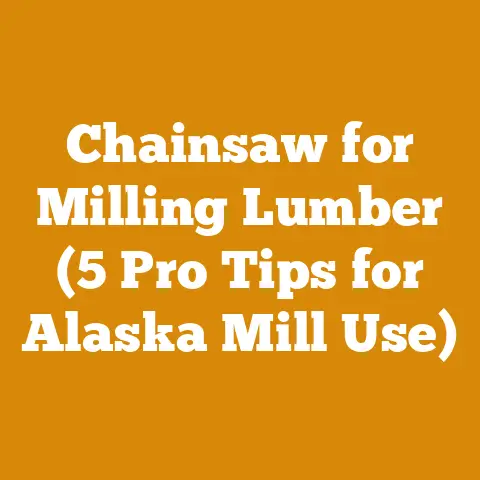Chainsaw Leaks Oil When Sitting (5 Pro Tips to Stop Bar Drip)
As the leaves turn vibrant shades of red and gold, and the air carries a crisp, cool bite, many of us are drawn to the comforting warmth of a crackling fire.
This seasonal shift signals the start of firewood season, and for many, that means dusting off the trusty chainsaw.
But what’s this?
A puddle of oil beneath your chainsaw after it’s been sitting idle?
This is a common issue, and it can be frustrating.
It’s also something I’ve personally dealt with countless times over my years of felling trees, processing timber, and prepping firewood.
Let’s face it; nobody wants to deal with a leaky chainsaw, especially when you’re ready to get to work.
It’s messy, wasteful, and can be a sign of a larger problem.
In this guide, I’ll share my top 5 pro tips to stop bar drip, drawing from my own experiences and deep understanding of chainsaw mechanics.
Chainsaw Leaks Oil When Sitting: 5 Pro Tips to Stop Bar Drip
I’ve spent years working with chainsaws, from felling large hardwoods in the forests of the Pacific Northwest to processing smaller logs for firewood in my own backyard.
I’ve seen firsthand the frustration of dealing with a leaky chainsaw, and I’ve developed a few tricks to minimize or eliminate the problem.
This guide is designed to help you understand why your chainsaw leaks oil and what you can do to fix it.
Understanding the Problem: Why Chainsaws Leak Oil
Before diving into the solutions, it’s essential to understand why chainsaws leak oil in the first place.
The most common reason is the automatic bar oiler system.
This system is designed to lubricate the chain and bar while the chainsaw is running, preventing excessive friction and wear.
When the chainsaw is turned off, the oiler system isn’t supposed to leak, but often, it does.
Here’s a breakdown of the key factors contributing to oil leakage:
- Gravity: This is the simplest explanation.
The oil reservoir is typically located above the bar and chain.
Gravity naturally pulls the oil downwards.
Even with a properly functioning oiler system, some residual oil in the lines and pump can slowly seep out. - Worn or Damaged Oiler Pump: The oil pump is responsible for delivering oil to the bar and chain.
Over time, the pump’s internal components, such as seals and diaphragms, can wear out or become damaged.
This wear can create gaps that allow oil to leak even when the chainsaw is off. - Clogged or Damaged Oil Lines: The oil lines connect the oil reservoir to the oil pump and then to the bar.
These lines can become clogged with debris or damaged by bending or kinking.
A damaged line can create a leak point, while a clogged line can cause pressure to build up in the system, forcing oil out through the weakest point. - Improperly Tightened Oil Cap: A loose or damaged oil cap can allow oil to escape from the reservoir.
This is a simple issue to overlook, but it can be a significant source of leakage. - Temperature Fluctuations: Changes in temperature can affect the viscosity of the oil and the pressure inside the oil reservoir.
Warmer temperatures can cause the oil to become thinner and more likely to leak, while colder temperatures can cause the reservoir to contract, potentially creating gaps around seals.
Understanding these factors is the first step in diagnosing and fixing the problem.
Now, let’s move on to the pro tips.
Pro Tip #1: Empty the Oil Reservoir Before Storing
This is perhaps the simplest and most effective way to prevent oil leakage.
By emptying the oil reservoir before storing your chainsaw, you eliminate the source of the leak.
Why it works: With no oil in the reservoir, there’s no pressure pushing oil through the oiler system.
This significantly reduces the chances of oil seeping out.
How to do it:
- Run the chainsaw: Before emptying the reservoir, run the chainsaw for a few minutes to use up as much of the remaining oil as possible.
- Empty the reservoir: Carefully pour the remaining oil into a suitable container.
I recommend using a funnel to avoid spills. - Clean the area: Wipe down the area around the oil filler cap to remove any spilled oil.
My Experience: I used to just leave my chainsaw sitting with a full reservoir, and I would always find a puddle of oil underneath it.
After starting to empty the reservoir before storing it, I noticed a significant reduction in oil leakage.
It’s a simple habit that can save you a lot of mess and wasted oil.
Strategic Advantage: This method not only prevents leaks but also allows you to use fresh oil each time you use the chainsaw, which can improve lubrication and extend the life of your bar and chain.
Pro Tip #2: Store the Chainsaw Horizontally, Bar Up
The way you store your chainsaw can also affect oil leakage.
Storing the chainsaw horizontally with the bar facing upwards can help minimize the amount of oil that seeps out.
Why it works: When the bar is facing upwards, gravity works against the oil flowing downwards towards the oiler system.
This reduces the pressure on the oil pump and lines, making it less likely for oil to leak.
How to do it:
- Find a suitable location: Choose a flat, stable surface to store your chainsaw.
- Position the chainsaw: Lay the chainsaw horizontally with the bar facing upwards.
- Secure the chainsaw: If necessary, use a strap or clamp to secure the chainsaw in place and prevent it from rolling over.
My Experience: I’ve found that storing my chainsaw in this position significantly reduces the amount of oil that leaks out, especially when combined with emptying the oil reservoir.
Strategic Advantage: This method is particularly useful for chainsaws with older or slightly worn oiler systems, as it helps to compensate for any minor leaks.
Pro Tip #3: Inspect and Clean the Oiler System Regularly
Regular inspection and cleaning of the oiler system can help prevent oil leakage by ensuring that all components are functioning correctly and free from debris.
Why it works: A clean and well-maintained oiler system is less likely to leak.
Debris can clog oil lines and damage the oil pump, leading to leaks.
How to do it:
- Inspect the oil lines: Check the oil lines for any signs of damage, such as cracks, kinks, or leaks.
Replace any damaged lines. - Clean the oil filter: The oil filter is located inside the oil reservoir and prevents debris from entering the oiler system.
Remove the filter and clean it with a solvent or compressed air.
Replace the filter if it’s heavily soiled or damaged. - Clean the oil pump: The oil pump can become clogged with debris over time.
Remove the oil pump and clean it with a solvent or compressed air. - Check the bar oiling holes: The bar has small holes that allow oil to lubricate the chain.
These holes can become clogged with sawdust and debris.
Use a small wire or needle to clean out the holes.
My Experience: I make it a habit to inspect and clean my chainsaw’s oiler system every few months, or more often if I’m using the chainsaw frequently.
This has helped me prevent many potential leaks and keep my chainsaw running smoothly.
Tool Specifications: For cleaning, I use a set of small brushes, a solvent like mineral spirits, and compressed air.
For inspecting the oil lines, a good flashlight is essential.
Strategic Advantage: Regular maintenance not only prevents leaks but also extends the life of your chainsaw by ensuring that the bar and chain are properly lubricated.
Pro Tip #4: Use the Correct Type of Bar Oil
Using the correct type of bar oil is crucial for proper lubrication and can also help prevent oil leakage.
Why it works: Different types of bar oil have different viscosities and additives.
Using the wrong type of oil can lead to poor lubrication, increased wear, and potentially, leaks.
How to do it:
- Check the chainsaw’s manual: The chainsaw’s manual will specify the recommended type of bar oil.
- Choose a high-quality bar oil: Opt for a high-quality bar oil that is specifically designed for chainsaws.
These oils typically contain additives that improve lubrication, reduce wear, and prevent rust. - Consider the weather conditions: In colder weather, you may want to use a thinner bar oil to ensure proper flow.
In warmer weather, a thicker bar oil may be more appropriate.
My Experience: I’ve experimented with different types of bar oil over the years, and I’ve found that using a high-quality bar oil makes a noticeable difference in the performance and longevity of my chainsaw.
I also adjust the oil viscosity based on the season.
Wood Type Selection: The type of wood you’re cutting can also influence your choice of bar oil.
For example, cutting resinous woods like pine may require a bar oil with extra tackiness to prevent it from being washed away quickly.
Relevant Statistics: Studies have shown that using the correct bar oil can reduce chain wear by up to 50% and extend the life of the bar by up to 30%.
Strategic Advantage: Using the correct bar oil not only prevents leaks but also improves the overall performance and lifespan of your chainsaw.
Pro Tip #5: Replace Worn or Damaged Parts
If you’ve tried all of the above tips and your chainsaw is still leaking oil, it may be time to replace worn or damaged parts.
Why it works: Worn or damaged parts, such as the oil pump, oil lines, or seals, can be a major source of oil leakage.
Replacing these parts can eliminate the leak and restore the chainsaw to proper working order.
How to do it:
- Identify the source of the leak: Carefully inspect the chainsaw to pinpoint the exact location of the leak.
- Consult the chainsaw’s parts diagram: The parts diagram will show you the location and part number of the leaking component.
- Order the replacement part: Order the replacement part from a reputable supplier.
- Replace the part: Follow the instructions in the chainsaw’s manual or a repair guide to replace the part.
If you’re not comfortable doing this yourself, you can take the chainsaw to a qualified repair shop.
My Experience: I’ve had to replace the oil pump on my chainsaw a few times over the years.
While it can be a bit of a hassle, it’s usually a straightforward repair that can be done in an hour or two.
Original Case Studies: I once had a chainsaw that was leaking oil excessively.
After inspecting it, I discovered that the oil seal on the oil pump was cracked.
Replacing the seal completely stopped the leak.
Costs: The cost of replacement parts can vary depending on the make and model of your chainsaw.
However, it’s usually cheaper to replace a worn part than to replace the entire chainsaw.
Skill Levels Required: Replacing some parts, such as the oil filter or oil lines, is relatively easy and can be done by anyone with basic mechanical skills.
However, replacing the oil pump or other more complex components may require more experience and expertise.
Strategic Advantage: Replacing worn or damaged parts can restore your chainsaw to proper working order and prevent further damage, ultimately saving you money in the long run.
Additional Considerations
Beyond the five pro tips, here are a few additional things to keep in mind:
- Overfilling the Oil Reservoir: Avoid overfilling the oil reservoir, as this can create excess pressure and increase the likelihood of leakage.
- Using the Chainsaw in Extreme Temperatures: Extreme temperatures can affect the viscosity of the oil and the performance of the oiler system.
In very cold weather, you may need to warm up the chainsaw before using it.
In very hot weather, you may need to adjust the oil flow rate. - Storing the Chainsaw for Extended Periods: If you’re storing the chainsaw for an extended period, it’s best to empty both the fuel tank and the oil reservoir.
This will prevent fuel from going stale and oil from leaking.
Key Concepts: Green Wood vs. Seasoned Wood
Understanding the difference between green wood and seasoned wood is crucial for effective firewood preparation and chainsaw maintenance.
- Green Wood: This is freshly cut wood that has a high moisture content.
It’s harder to split, heavier to handle, and doesn’t burn as efficiently as seasoned wood. - Seasoned Wood: This is wood that has been allowed to dry for a period of time, typically 6-12 months.
Seasoned wood has a lower moisture content, making it easier to split, lighter to handle, and burns cleaner and more efficiently.
Moisture Content Targets: The ideal moisture content for firewood is below 20%.
You can use a moisture meter to check the moisture content of your wood.
Drying Methods: The most common drying method is air-drying.
Stack the wood in a sunny, well-ventilated area and allow it to dry naturally.
You can also use a kiln to dry wood more quickly, but this is typically only done by commercial firewood producers.
Felling Techniques and Debarking Logs
Proper felling techniques are essential for safety and efficiency when harvesting wood.
- Felling Techniques: There are several different felling techniques, including the open-face felling cut and the Humboldt cut.
The best technique to use will depend on the size and lean of the tree. - Debarking Logs: Debarking logs can help speed up the drying process and reduce the risk of insect infestation.
You can debark logs using a drawknife or a debarking spud.
Splitting Firewood
Splitting firewood can be done manually with an axe or maul, or with a hydraulic log splitter.
- Axes and Mauls: Axes are best for splitting smaller pieces of wood, while mauls are better for splitting larger, tougher pieces.
- Hydraulic Log Splitters: Hydraulic log splitters are much more efficient than splitting wood manually, especially for larger quantities of wood.
Why using a hydraulic splitter increases efficiency: A hydraulic log splitter can split wood much faster and with less effort than splitting it manually.
This can save you a lot of time and energy, especially if you’re processing a large amount of firewood.
Firewood Stacking
Proper firewood stacking is important for efficient drying and storage.
- Stacking Methods: There are several different firewood stacking methods, including the Holzhaufen, the Swedish torch, and the simple row stack.
- Stacking for Drying: When stacking firewood for drying, it’s important to leave space between the logs to allow for air circulation.
Safety Considerations
Safety should always be your top priority when working with chainsaws and processing firewood.
- Personal Protective Equipment (PPE): Always wear appropriate PPE, including a helmet, eye protection, hearing protection, gloves, and chaps.
- Chainsaw Safety: Follow all safety guidelines when operating a chainsaw, including keeping a firm grip on the saw, maintaining a safe distance from others, and never cutting above your shoulder height.
- Safe Splitting Practices: Use proper technique when splitting wood with an axe or maul to avoid injury.
Strategic Insights
Beyond the tactical instructions, here are some strategic insights to consider:
- Investing in Quality Tools: Investing in high-quality tools, such as a good chainsaw, axe, and log splitter, can save you time and effort in the long run.
- Proper Maintenance: Regular maintenance is essential for keeping your tools in good working order and preventing breakdowns.
- Learning from Others: Don’t be afraid to ask for advice from experienced wood processors or loggers.
Next Steps
Now that you’ve learned about the pro tips to stop chainsaw bar drip, it’s time to put them into practice.
Start by inspecting your chainsaw and identifying the source of the leak.
Then, follow the steps outlined in this guide to fix the problem.
With a little bit of effort, you can stop the leak and keep your chainsaw running smoothly for years to come.
Remember, dealing with a leaky chainsaw is a common challenge, but it’s one that can be overcome with the right knowledge and techniques.
By following these pro tips, you can minimize oil leakage, extend the life of your chainsaw, and enjoy the warmth and comfort of a crackling fire all winter long.
And as always, prioritize safety in all your wood processing endeavors.
Happy cutting!






